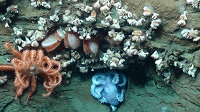Contacts: Marjorie.Weisskohl@boem.gov
703-787-1304
The Bureau of Ocean Energy Management (BOEM) announces the availability of a new video, Pathways to the Abyss, showcasing the deepwater marine habitats of two mid-Atlantic Canyons located 100 miles offshore Virginia and Maryland. The film is the product of a five-year study sponsored by the National Oceanographic Partnership Program (NOPP) and funded by BOEM, the U.S. Geological Survey (USGS) and the National Oceanic and Atmospheric Administration (NOAA). It includes interviews with scientists from universities, research institutions, the private sector and the federal government who participated in research cruises to the Norfolk and Baltimore Canyons from 2011 to 2013.
The research findings are significant and depict a biologically rich region that had not been fully explored in the
past. The researchers:
- found an unexpected, high density of corals and some varieties not previously known to occupy this region, such as Lophelia pertusa;
- identified more than 125 species of fishes, including one species from Greenland, plus other marine life;
- made a dramatic discovery of large swaths of chemosynthetic mussels and associated communities near the Norfolk Canyon, possibly the largest areas of cold seep communities in the North Atlantic (each more than a kilometer in length);
- documented historically important shipwrecks off the coast of Virginia; and
- deployed special technologies called benthic landers and moorings to the canyon floors to collect previously unavailable oceanographic data over the course of a year. Data on the ocean’s currents, temperatures, salinity and chemistry from the landers, which were designed and engineered by researchers from the University of North Carolina Wilmington, from the Netherlands and the USGS, is being analyzed, and will add to the body of knowledge about the canyons as well as the broader western Atlantic Ocean.
The National Oceanographic Partnership Program (NOPP) served as the umbrella for leveraging the resources of BOEM, USGS, NOAA’s Office of Ocean Exploration, 12 universities and research institutions, and two companies. The federal agencies contributed equally to the study – funding approximately $9 million total between them over three years. The partnership demonstrates that the public and private sector can achieve more scientifically by working together than working alone, and that partnerships can be extremely effective to meet overlapping science needs.
Sec. Jewell presented the DOI Partners in Conservation Award to the research team in January 2014. Members included CSA Ocean Sciences as the prime contractor, and lead Principle Investigators from the University of North Carolina Wilmington and Florida State University. The archaeology lead was from the University of Rhode Island, and scientists from 11 other research institutions participated in the research. ArtWork produced the photos and videography.
For BOEM, the timing of the film and the overall study demonstrates the strategic nature of its Environmental Studies Program. The research contributes updated environmental and ecological information to inform reviews, future decisions and mitigation measures related to offshore energy and minerals. Analysis of this information will enrich the field of marine science for all to use. A final report on the study is expected in late 2015 or early 2016.
The USGS principal investigators who directly participated in this project conducted complementary research examining canyon geology, oceanography, ecology, animal and microbial distribution, and genetics. USGS is a multi-disciplinary science organization providing reliable scientific information to describe and understand the Earth; minimize loss of life and property from natural disasters; manage water, biological, energy and mineral resources; and enhance and protect our quality of life.
NOAA’s Office of Ocean Exploration and Research and Office of Marine and Aviation Operations supported this study in numerous ways, including with several ships and assets such as remotely operated vehicles (ROVs), and with education and outreach efforts. NOAA involvement in the expeditions contributed to new discoveries to support management decisions.
For more background, see links to the 2011, 2012 and 2013 research cruises.
BOEM’s Environmental Studies Program develops, funds, and manages rigorous scientific research to inform policy decisions regarding the development of energy and mineral resources on the Outer Continental Shelf. Join us on Facebook, Twitter and our other social media channels.
- BOEM -
BOEM promotes energy independence, environmental protection and economic development through responsible, science-based management of offshore conventional and renewable energy and marine mineral resources.


